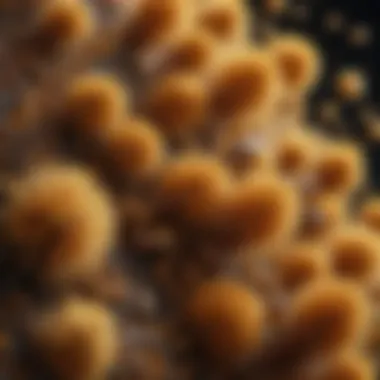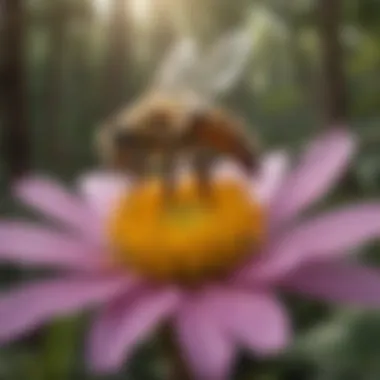Understanding the Role and Impact of Pollen


Intro
Pollen plays a crucial role in various ecological systems, impacting both agricultural practices and biodiversity. Understanding its complexities extends beyond simple biology; it encompasses environmental science and forestry management. This article will investigate the significance of pollen, addressing its composition, types, and interactions with ecosystems.
Overview of Forestry Practices
Forestry practices are essential in managing forested lands, providing benefits such as timber production, recreational opportunities, and habitat preservation. Understanding these practices can guide sustainable management and help balance immediate economic needs with long-term ecological health.
Importance of Foresting
Forests contribute significantly to global biodiversity, providing habitat for wildlife and serving as crucial carbon sinks. Moreover, they help to regulate the climate and air quality. Foresting efforts must be approached with care to avoid degradation and loss of ecosystems.
Types of Forestry Practices
- Clear-Cutting: This involves removing all trees in a specific area, which can lead to soil erosion and loss of habitat.
- Selective Logging: This method aims to conserve the environment by only taking certain trees, allowing the forest to regenerate naturally.
- Agroforestry: Combining agriculture and forestry, this system promotes land-use efficiency while enhancing biodiversity.
- Reforestation: Planting trees in deforested areas to restore the ecosystem, supporting wildlife habitats and soil health.
Best Practices for Sustainable Woodland Stewardship
Sustainable forestry practices focus on ensuring that forest resources are managed responsibly for current and future generations.
Principles of Sustainable Forestry
- Sustainability: Forests must be managed in a way that maintains their biodiversity, productivity, and ecological processes.
- Community Involvement: Engaging local communities fosters stewardship and aligns practices with cultural values and needs.
- Adaptive Management: Monitoring and adapting strategies based on changing ecological and economic conditions ensures resilience.
Techniques for Land Management
Effective land management techniques can enhance forest health and productivity. Some commonly used strategies include:
- Controlled Burns: Reducing excess vegetation to prevent wildfires and promote new growth.
- Soil Conservation Practices: Techniques such as terracing and contour farming help maintain soil structure and health.
- Buffer Zones: Establishing areas along water bodies to filter pollutants and habitat protection.
Innovative Techniques in Forestry
Advancements in technology and methodologies offer exciting opportunities for enhancing forestry practices.
Latest Technological Advancements
- Remote Sensing: Using satellite imagery for monitoring forest health and biodiversity.
- Drone Technology: Employing drones for tree inventories, mapping, and assessing damage from pests or natural disasters.
- Data Analytics: Analyzing large datasets to make informed decisions about forest management.
Integrating Traditional Knowledge with Modern Science
Combining ancient practices with contemporary research can create more effective and culturally sensitive forest management approaches. This can enrich ecological understanding and promote resilient ecosystems.
Understanding the complex interrelations between pollen, forestry, and biodiversity is vital for effective environmental stewardship.
By delving into the multifaceted aspects of pollen and its significance within forestry, we can foster a more sustainable and ecologically balanced approach to land management.
Foreword to Pollen
Pollen is an essential element in the reproductive processes of many plants. Understanding its nature provides valuable insight into the broader ecology and various systematic operations in nature. The intricacies of pollen are multifaceted, encompassing aspects of biodiversity, agriculture, and environmental science. It impacts everything from food production to ecosystem stability. As issues like climate change and habitat loss emerge, the relevance of pollen's roles can not be underestimated.
The importance of studying pollen extends beyond its primary function in reproduction. It serves as a resource for other organisms, contributing to food chains. Moreover, pollen grains have been used historically in various fields, such as forensics and paleobotany. The information gleaned from pollen analysis helps in understanding past climates, pollination strategies, and evolution of species.
A comprehensive understanding of pollen can enhance practices in forestry and agriculture, particularly through important metrics in ecosystem health and sustainability. As such, a closer examination of pollen's definitions, historical context, and its significant roles within various ecosystems becomes paramount in understanding its current impacts and future implications.
Definition of Pollen
Pollen consists of tiny granules produced by seed plants during their reproductive processes. Essentially, each grain is a male gametophyte, which contributes to fertilization when visiting other flowers. Pollen is a complex structure, typically comprising four parts: the exine, intine, cytoplasm, and nucleus. The outer shell, or exine, is often thick and sculptured, providing protection against environmental factors. The composition and structure may vary greatly depending on plant species, which ultimately contributes to its distinctive features.
History of Pollen Studies
The study of pollen is a rich field that stems back several centuries. Initial investigations took place in the 17th century when pioneering botanists such as Antonie van Leeuwenhoek first employed microscopes to explore pollen grains. His findings laid the groundwork for understanding the fundamental role of pollen in plant reproduction. Over the years, the development of innovative analytical techniques, such as palynology—the study of pollen—has expanded the scope of research dramatically.
Significant advancements in pollen studies occurred during the 20th century, when scientists began utilizing pollen analysis for diverse applications, including environmental reconstructions and agricultural improvements. Palynological research has revealed crucial details about ancient climates and ecosystems. Hence, pollen studies continue to be an essential tool for researchers aiming to connect past environmental changes with current ecological trends. The continuous evolution in this field allows scientists to address more contemporary issues, ranging from biodiversity loss to the effects of climate change.


Composition of Pollen
The composition of pollen is a fundamental topic within pollen studies, as it lays the groundwork for understanding its role and impact on ecosystems. Pollen grains are not mere reproductive units; they consist of intricate structures and chemicals that serve various functions. Analyzing these components provides insights into biodiversity, species interactions, and environmental responses.
Chemical Structure
Pollen grains have a unique chemical structure that includes several key components. Firstly, they are primarily made of sporopollenin, a robust biopolymer that forms the exine, or the outer layer of the grain. This substance is resistant to decay and protects the genetic material it carries during the dispersal process. The inner part, known as the intine, is primarily made of cellulose and pectin, further enhancing the structural integrity of the pollen grain.
Moreover, pollen can contain proteins, lipids, carbohydrates, and minerals. These constituents are not solely structural; they play vital roles in the pollen's interaction with pollinators and the environment. For instance, proteins present in pollen are essential for the nutrition of insects and other animals that consume pollen, thereby linking pollen to various ecological processes.
Variability Among Species
Variability in pollen composition is observable among different species of plants. This variability can be attributed to evolutionary adaptations, environmental factors, and ecological relationships.
- Species-Specific Variations: Different plant species produce pollen with distinctive characteristics. For instance, angiosperms often have more complex pollen structures compared to gymnosperms. These structural differences can influence how efficiently pollen is transferred and how well it can resist environmental stressors.
- Environmental Influence: Environmental conditions play a significant role in shaping pollen composition. Variables such as soil nutrients, climate, and altitude can alter the biochemical makeup of pollen grains. For example, higher levels of certain minerals in the soil may lead to increased pollen protein content, affecting the nutritional value of pollen for pollinators.
- Ecological Interactions: The composition may also reflect the ecological dynamics between plants and their visitors. Some plants produce pollen rich in specific nutrients to attract certain pollinators. In contrast, other species might adapt their pollen composition in response to competition for pollination.
Understanding the composition of pollen can contribute to conservation strategies, as it aids in recognizing plant-pollinator interactions and their roles in ecosystems.
In summary, the composition of pollen is not just about what it is made of; it reflects the interactions between species and their environment. An in-depth understanding of this composition is vital for forestry professionals and researchers engaged in ecological studies.
Types of Pollen
Understanding the different types of pollen is crucial, as this knowledge informs various factors within ecosystem dynamics and agricultural practices. Pollen behaves differently depending on its type, affecting reproduction success in plants, influencing pollinator behavior, and ultimately impacting biodiversity. Examining pollen classification provides insight into the traits that help plants adapt to their environments. This section will break down the distinctions between angiosperm and gymnosperm pollen and explore how pollen can be categorized based on its physical characteristics, such as shape and size.
Angiosperm vs. Gymnosperm Pollen
Angiosperms and gymnosperms represent two broad classifications of plants that produce distinct types of pollen. Angiosperms, or flowering plants, produce pollen grains that are often more complex in structure compared to gymnosperms, which include conifers like pines and spruces.
Key Differences:
- Pollen Structure:
- Pollination Methods:
- Ecological Impact:
- Angiosperm Pollen: Typically smaller and more diverse in shape. They can have intricate surface patterns which may aid in attachment to pollinators.
- Gymnosperm Pollen: Generally larger and less varied in shape. The surface is often smoother and less intricate, indicating adaptation to wind dispersal.
- Angiosperms: Frequently rely on animals, especially insects, for pollination due to their bright flowers and nectar.
- Gymnosperms: Mainly utilize wind for pollen dispersal, which requires producing a larger quantity of pollen to ensure effective fertilization.
- Angiosperm Pollen: Supports a wide range of pollinators, contributing to biodiversity.
- Gymnosperm Pollen: Plays a critical role in forest ecosystems but usually supports fewer types of pollinators.
Categorization Based on Shape and Size
Pollen grains can also be categorized based on their shape and size, which are important for understanding their role in various ecological contexts. The physical characteristics of pollen shape and size affect its transport, availability to pollinators, and susceptibility to environmental factors.
Classification Based on Shape:
- Spherical: Commonly found in many angiosperms. Their round shape allows for easier landing on the adhering surfaces of pollinators.
- Elongated: Often observed in some grasses, elongated grains might optimize wind transportation.
- Triangular or irregular: Seen in certain species that rely on different pollination strategies.
Classification Based on Size:
- Micro-pollen: Typically less than 10 micrometers. Can travel longer distances in the air.
- Macro-pollen: Generally larger than 10 micrometers. More likely to fall close to the source due to gravity.
Understanding these classifications aids in predicting plant behavior, pollen dispersal patterns, and ecological interactions. The characteristics of pollen play a central role in influencing both reproduction in plants and the health of ecosystems overall.
"Pollen varies tremendously in both structure and function across different plant types, providing key insights into ecological relationships."
Pollen Dispersal Mechanisms
Pollen dispersal is a critical process in plant reproduction. Understanding different mechanisms can enhance our awareness of ecological dynamics and biodiversity. Pollen dispersal mechanisms impact genetic diversity, species survival, and the overall health of ecosystems. Each method has its unique advantages and challenges that can influence the success of reproductive strategies in various environments.
Wind Pollination
Wind pollination, also known as anemophily, is one of the most ancient and widespread mechanisms for pollen transfer. It primarily involves the release of large quantities of lightweight pollen grains into the atmosphere. Trees like pine, oak, and grasses utilize this mechanism successfully.
Advantages of wind pollination include:
- Widespread Reach: Pollen can travel long distances, making it possible for plants in isolated areas to reproduce.
- Efficiency: Once the pollen is airborne, it requires no additional energy for transfer.


However, there are disadvantages to consider:
- Low Success Rates: A significant amount of pollen may not reach the target flowers, leading to reduced fertilization chances.
- Dependency on Weather: Wind speed and direction can heavily influence the effectiveness of this mechanism.
Insect Pollination
Insect pollination, ceted entomophily, involves various insects such as bees, butterflies, and moths facilitating pollen transfer. These insects are attracted to flowers by color, scent, and nectar.
Benefits of this method are multiple:
- Higher Fertilization Rates: Insects often transfer pollen more effectively than wind, leading to better fertilization success.
- Mutualism: The relationship benefits both plants and pollinators; while insects collect nectar, they aid in the plant’s reproductive processes.
However, insect pollination comes with some challenges:
- Limited Range: Unlike wind, which can carry pollen far away, insects typically travel shorter distances.
- Dependency on Specific Species: The decline of particular pollinator species can significantly impact plants that rely on them.
Self-Pollination Strategies
Self-pollination, or autogamy, occurs when pollen from the same flower fertilizes its ovules. This method often occurs in plants that possess perfect flowers containing both male and female reproductive structures.
Some advantages of self-pollination:
- Guaranteed Reproduction: In the absence of compatible mates, plants can still reproduce.
- Rapid Colonization: This method allows plants to quickly occupy new niches and ensure survival in new environments.
Yet, self-pollination also has disadvantages:
- Reduced Genetic Diversity: Genetic uniformity can increase susceptibility to diseases and environmental changes.
- Dependence on Localized Conditions: If environmental conditions change dramatically, self-pollinating species might struggle to adapt due to lack of genetic variability.
Pollen dispersal mechanisms each play a distinct role in sustaining plant reproductive success, and understanding these can help in conservation efforts and agricultural practices.
Assessment of these mechanisms can provide insights for forestry professionals and researchers interested in sustainable practices. By recognizing how different plants reproduce, one can better predict ecological outcomes and guide conservation strategies.
Ecological Role of Pollen
Pollen plays a vital role in ecosystems by facilitating reproduction in flowering plants and contributing to overall biodiversity. Understanding the ecological role of pollen provides insights into its significance in ecosystems and highlights the importance of conserving pollinators and their habitats. As we explore the interactions pollen has with various organisms, we can appreciate how it sustains both floral and faunal communities.
Pollen and Biodiversity
The interplay between pollen and biodiversity is complex. Pollination is necessary for the reproduction of many plants. The availability of diverse pollen resources directly influences the diversity of plant species in an ecosystem. Areas rich in various flowering plants provide habitats for numerous pollinators, such as bees, butterflies, and birds. This relationship fosters a dynamic network of ecological interactions. Additionally, diverse plant life contributes to soil health and prevents erosion.
Pollen diversity is a key indicator of overall ecosystem health. It reflects the condition of flora and the well-being of associated fauna.
Moreover, pollen can also indicate shifts in ecosystems caused by human activities or climate change. Monitoring changes in pollen types and abundance allows researchers to infer biodiversity trends and potential ecological shifts over time.
Pollen as a Food Resource
Role in Supporting Pollinator Populations
Pollen serves as an essential food source for many pollinator species. It offers a rich supply of proteins and nutrients necessary for their growth and reproduction. Many bee species, for example, gather pollen to feed their young. This put pollen at the forefront of supporting pollinator populations, which are critical for the pollination of both wild plants and agricultural crops.
Pollen's nutritional value is among its most key characteristics. It contains essential amino acids, vitamins, and minerals. This combination makes it a beneficial choice for sustaining pollinator communities. However, due to habitat loss and pesticide use, the availability of diverse pollen sources is diminishing.
Contribution to Ecosystem Stability
Pollen contributes to ecosystem stability by enhancing genetic diversity among plant populations. This genetic variability is crucial. It ensures that plant species can adapt to changing environmental conditions, thus maintaining ecological balance. A steady supply of pollen helps sustain different plant species, which in turn supports a variety of animal life.
The unique feature of this aspect is its capacity to create resilient ecosystems. Diverse plant populations can better withstand diseases and environmental stressors. However, disturbances like climate change may disrupt this delicate balance.
Impacts of Pollen on Human Health
Pollen has a significant influence on human health, demonstrating both beneficial and detrimental impacts. Understanding these effects is crucial for individuals who experience allergy symptoms and those who may use pollen for nutrition or health supplements. In this segment, two primary aspects are explored: allergies and respiratory issues, alongside nutritional benefits of pollen.
Allergies and Respiratory Issues
Pollen is one of the most common allergens affecting a vast number of people globally. Seasonal allergies, also known as hay fever, arise when pollen from trees, grasses, and weeds enters the respiratory system. Symptoms include sneezing, nasal congestion, itchy eyes, and even asthma attacks in sensitive individuals.


Pollen levels fluctuate throughout the year, often rising in specific seasons. For example, tree pollen is prominent in spring, while grass pollen tends to dominate late spring and early summer. In contrast, weed pollen, such as ragweed, often peaks in late summer and fall. Different individuals react to different types of pollen, making it vital to understand local pollen counts, which are available via online resources.
"Interventions such as antihistamines and decongestants can alleviate symptoms, but understanding triggers is crucial in managing pollen exposure effectively."
Nutritional Aspects of Pollen
Beyond its role as an allergen, pollen can also contribute to human health as a food source. Rich in proteins, vitamins, and minerals, pollen has been consumed in various cultures for its health benefits. Some key aspects of pollen nutrition include:
- High Protein Content: Pollen is composed of approximately 20-30% protein, containing essential amino acids necessary for various bodily functions.
- Vitamins and Minerals: It offers vitamins B, C, and E, along with minerals like zinc, iron, and calcium, supporting overall health.
- Antioxidant Properties: Pollen contains antioxidants that may help combat oxidative stress in the body.
There are potential considerations regarding pollen consumption, particularly for individuals with allergies. Proper sourcing and quality control of pollen products are important to ensure safety for those who may have sensitivities. Additionally, certain studies suggest that consuming local pollen may aid in desensitizing allergic reactions, though more research is needed to confirm these claims.
Pollen serves as a reminder of the intricate relationship between us and our environment, highlighting both its risks and rewards for human health.
Pollen and Climate Change
Pollen and climate change represents a significant intersection of ecological research and environmental concern. Understanding how climate influences pollen production is crucial for comprehending broader ecological dynamics. Changes in temperature and precipitation patterns can directly affect pollen viability, abundance, and dispersal. Such alterations, in turn, can have cascading effects on plant reproduction, biodiversity, and food security.
Effects of Climate on Pollen Production
Climate change can modify the phenological patterns of plants, impacting when and how much pollen is produced. For instance, warmer temperatures may lead to earlier flowering times, affecting species that rely on synchronized blooming for pollination.
- Increased CO2 Levels: Higher carbon dioxide levels can enhance plant growth, potentially increasing pollen production among some species, but may also lead to a decrease in pollen quality.
- Temperature Fluctuations: Rising temperatures can lead to mismatches between plant and pollinator life cycles, disrupting ecological relationships.
- Moisture Changes: Variations in rain patterns affect soil moisture, influencing pollen yield. Drought conditions may restrict pollen production, while excessive moisture can lead to mold, impacting pollen viability.
"Climate change acts as a catalyst in the ecological processes, with pollen dynamics playing a pivotal role in assessing the ecological balance."
Pollen as an Indicator of Ecological Change
Pollen serves as a valuable ecological indicator due to its sensitivity to environmental shifts. By studying pollen records, scientists can track historical climate changes and predict future trends. This is particularly useful in the context of climate change.
- Fossil Pollen Analysis: Researchers analyze sediment cores containing fossilized pollen to understand past vegetation and climate conditions.
- Current Pollination Patterns: Changes in current pollen distribution offer insights into how ecosystems are responding to climate shifts.
- Biodiversity Monitoring: Pollen diversity can reflect the health of ecosystems. A decline in diverse pollen types can signal threats to biodiversity due to habitat loss or climate stresses.
Research Trends in Pollen Studies
The exploration of pollen studies has advanced significantly over the years. Understanding these research trends is vital for several reasons. Firstly, the state of pollen research directly impacts ecological knowledge and management strategies in forestry. Pollen not only plays a critical role in plant reproduction but also serves as an important ecological indicator. Therefore, staying updated on current trends can guide effective conservation efforts and sustainable practices.
Emerging Techniques in Pollen Analysis
Recent developments in pollen analysis techniques greatly enhance our capacity to study pollen grains. Advanced microscopy methods, such as Scanning Electron Microscopy (SEM), reveal finer details of pollen morphology. This level of detail enables researchers to distinguish between closely related species, thus providing more accurate ecological assessments.
Additionally, molecular techniques like DNA barcoding allow for the identification of pollen at a genetic level. This can be particularly useful in studies on plant-pollinator interactions and community dynamics. The integration of these emerging techniques with traditional methods fosters a more holistic approach toward understanding pollen in ecological contexts.
Interdisciplinary Approaches to Pollen Research
Pollen research benefits immensely from interdisciplinary collaboration. Combining expertise from fields such as ecology, botany, climatology, and even data science leads to more comprehensive studies. For instance, studying the effects of climate change on pollen production requires insights from climate sciences alongside ecological research.
Furthermore, involving social sciences can illuminate the human dimensions of pollen, such as public awareness about pollen allergies and its implications for health policies. This cross-pollination of disciplines encourages innovative methods and broadens the scope of inquiry.
"Interdisciplinary approaches allow for a better understanding of complex environmental issues. They bring together diverse perspectives that enrich the research outcomes."
Pollen and Sustainable Practices
The relationship between pollen and sustainable practices is critical in addressing current environmental challenges. Pollen affects ecosystems in multiple ways, which can be harnessed to promote sustainability. Recognizing the value of pollen in agriculture and ecosystem management leads to better decision-making in sustainable land use. Moreover, pollen plays a key role in the health of pollinators, which are vital for crop production and biodiversity.
Conservation of Pollinator Habitats
Conserving pollinator habitats is essential for sustaining ecosystems. Habitat loss threatens both plants and pollinators. Ensuring that areas rich in diverse flowering plants are preserved allows pollen to disperse effectively. This can lead to better reproductive success in plants and help maintain ecological balance. Key considerations for habitat conservation include:
- Creating green spaces where diverse plant species can flourish.
- Restricting pesticide use to minimize harm to pollinators.
- Establishing wildlife corridors that connect fragmented habitats.
These actions not only protect pollinators but also sustain the plants that depend on them. Pollen conservation strategies can enhance both agricultural yields and the natural environment. Maintaining healthy ecosystems benefits surrounding communities and preserves biological diversity.
Promoting Biodiversity through Pollen Management
Pollen management is an integral part of promoting biodiversity. Recognizing how different plant species produce pollen can inform planting strategies. These strategies can boost pollinator populations by offering adequate food sources throughout the growing season. Important elements of pollen management include:
- Selecting plants that bloom at various times to provide a continuous pollen supply.
- Encouraging a mix of indigenous and nectar-rich exotic plants to attract diverse pollinator species.
- Implementing agroecological practices that integrate pollen-producing plants into agricultural landscapes.
"Understanding the role of pollen in our ecosystems is crucial for future conservation and agricultural strategies."
Emphasizing efficient use of resources, pollen management enhances the productivity of landscapes while benefiting both human needs and environmental health.















